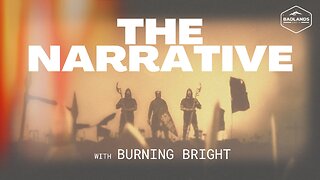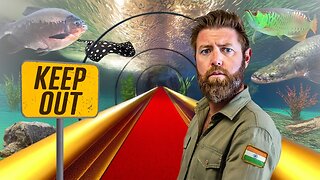Premium Only Content

Can Humans Fly Like Birds | What If Humans Have Wings
Can Humans Fly Like Birds | What If Humans Have Wings
Subscribe to Daily Dose Of Fact - https://bit.ly/2Z4b0m0
The idea of humans having wings is a fascinating one that has captured the imaginations of people for centuries. If humans had wings, it would fundamentally change the way we interact with our environment and the world around us.
This idea has been around for centuries, and can be found in mythology and folklore from around the world. Examples include the Greek god Hermes, the Roman god Mercury, and the Hindu god Garuda.
Firstly, it's important to note that there are several challenges that would need to be overcome in order for humans to have functional wings. We would need to have a lightweight yet sturdy bone structure, powerful chest and back muscles, and a highly efficient respiratory system. Additionally, we would need to develop the necessary neural pathways to control our wings and maintain balance in flight.
Assuming these challenges could be overcome, humans with wings would have a range of new abilities and experiences. Flight would allow us to travel great distances quickly and easily, without the need for vehicles or infrastructure. This would change the way we think about transportation, and could lead to a more decentralized and interconnected society.
Winged humans would also have a new perspective on the world around them. We would be able to see things from a bird's-eye view, and gain a greater understanding of the natural world and its patterns and rhythms. We could use this new perspective to better understand weather patterns, migration patterns, and other natural phenomena.
The largest wingspan ever recorded on a bird belongs to the wandering albatross, with a wingspan of up to 11 feet (3.4 meters). If humans had wings of a similar size, it would dramatically change the way we interact with our environment.
Flying would require a lot of energy, and a winged human would need to consume a lot of calories in order to maintain flight. It's possible that we would need to adapt our diet and lifestyle in order to accommodate this increased energy demand.
If humans had wings, it's likely that we would also have to develop new technologies and safety protocols to ensure that flying was safe and efficient. This could include the development of new types of aircraft, as well as new methods for controlling and navigating our wings.
The idea of humans with wings has captured the imaginations of many writers and artists over the years. Some examples include the novel "Skymaze" by Richard A. Lupoff, the manga series "Birdmen" by Yellow Tanabe, and the animated film "Howl's Moving Castle" by Hayao Miyazaki.
There are many practical applications for flight that could benefit humans if we had wings. For example, we could use our wings to conduct aerial surveys, monitor wildlife populations, and respond to emergencies in remote or hard-to-reach areas.
The mechanics of how humans would use their wings to fly would be complex and varied. Some people might rely on a flapping motion, while others might use a gliding or soaring technique.
Flying would also require a high level of skill and training, and it's likely that winged humans would need to undergo extensive physical and mental conditioning in order to master the art of flight.
If humans had wings, it's likely that we would also need to develop new forms of clothing and equipment to accommodate our wings. This could include specially designed flight suits, helmets, and harnesses.
One of the biggest challenges facing winged humans would be the issue of air pollution. As humans fly through the air, they would be exposed to higher levels of pollution than they would on the ground. This could have significant health implications over time.
The idea of humans with wings has been explored in many works of fiction, from classic literature like "The Island of Dr. Moreau" by H.G. Wells, to modern films like "Avatar" and "Maleficent".
Some people have even attempted to create functional wings that could be used by humans. For example, in the early 20th century, inventor Otto Lilienthal developed a series of gliders that allowed him to fly short distances.
On the other hand, there would also be some drawbacks and challenges to having wings. Flight can be physically demanding and exhausting, and it would require a lot of energy to maintain. This could limit our ability to fly for extended periods of time, and may make it difficult to carry heavy loads while in flight.
Additionally, there would be safety concerns to consider. Flying is inherently risky, and we would need to develop new safety protocols and technologies to ensure that accidents and crashes are minimized.
-
 3:20:44
3:20:44
Badlands Media
23 hours agoThe Narrative Ep. 27 - A Spectacular Success
104K14 -
 1:21:56
1:21:56
Man in America
16 hours agoExposing Big Pharma’s #1 WEAPON for Keeping You SICK w/ Dr. Edward Group
66.2K22 -
 15:53
15:53
Forrest Galante
22 hours agoPrivate Tour of India’s Best Secret Aquarium
131K11 -
 5:44:01
5:44:01
Spartan
10 hours agoPro Halo Player | Sens Crisis Grind | Ranked Arena, Probably SWTOR at some point
63.9K -
 2:38:46
2:38:46
vivafrei
17 hours agoEp. 269: U.S. Strikes Iran! Karen Read Verdict! Grace Schara Verdict! National Gaurd, SCOTUS & MORE!
243K478 -
![Batman Arkham Knight [4K + Mods] Hardest Difficulty ⋆ Western Re-tread](https://1a-1791.com/video/fww1/ca/s8/1/7/9/T/V/79TVy.0kob-small-Batman-Arkham-Knight-4K-Mod.jpg) 3:50:55
3:50:55
FusedAegisTV
11 hours agoBatman Arkham Knight [4K + Mods] Hardest Difficulty ⋆ Western Re-tread
72.6K3 -
 2:25:09
2:25:09
Tundra Tactical
11 hours ago $12.29 earned🚨🔫Tundra Nation Live Rips Apart Media Lies on Short Barreled Rifles & Suppressors 🎇🧨
123K1 -
 2:47:06
2:47:06
Barry Cunningham
13 hours agoPRESIDENT TRUMP PROTECTED AMERICA AND NOW THE WORLD AND THAT DEMOCRATS KNOW!
83.8K76 -
 2:05:24
2:05:24
Joker Effect
8 hours agoSoundboard Lord / Midnight In The Mountains talk about Gaming on the Rumble platform. Is it good?
42.9K2 -
 2:49:44
2:49:44
Cewpins
8 hours agoLet's Get HIGH!🔥Rumble Creator Sesh at Midnight! 💨420🍃Switch 2 !giveaway
27.1K13